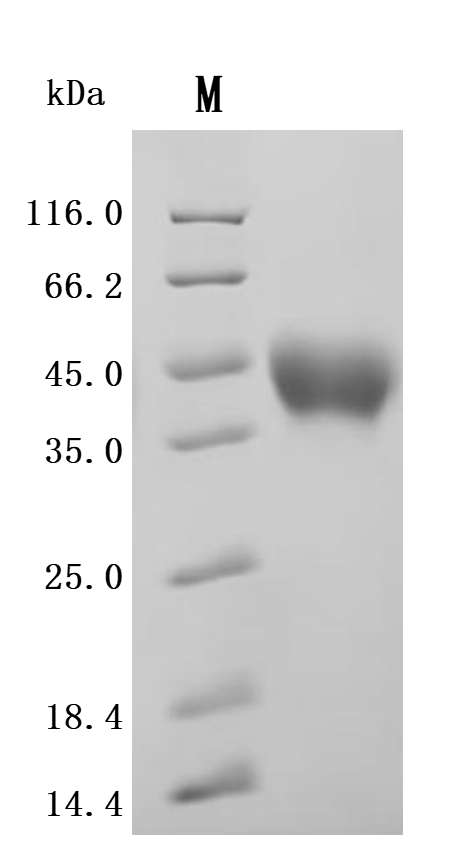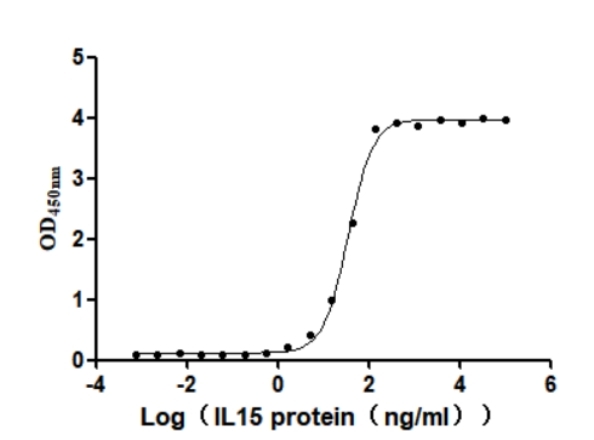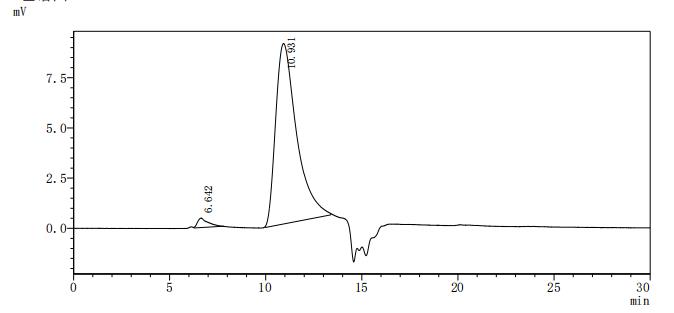The recombinant human IL15RA protein, an active form of the interleukin-15 receptor alpha (31- 205aa), is produced with a high purity level exceeding 95%, as confirmed by both SDS-PAGE and SEC-HPLC methods. This high purity is crucial as it minimizes contaminants that could potentially interfere with biological activity, ensuring reliable experimental outcomes. This recombinant IL15RA protein is expressed in mammalian cells. It exhibits significant biological activity, which is measured through its binding capacity in a functional ELISA. Specifically, when immobilized at a concentration of 2 μg/mL, IL15RA can effectively bind to human IL15, with an EC50 value ranging from 32.53 to 38.41 ng/mL. This indicates a strong interaction between IL15RA and its ligand, which is essential for its role in immune response modulation.
The IL15RA protein plays a crucial role in the immune response as a component of the IL-15 signaling pathway. IL15RA primarily binds IL-15, a cytokine essential for regulating and activating T cells, natural killer (NK) cells, and other immune cells. It can function in both cis and trans configurations, enhancing IL-15 signaling by presenting the cytokine to neighboring cells and facilitating the activation of intracellular signaling pathways, including the Jak-STAT and PI3K/AKT pathways [1][2].
The presence of IL15RA is often associated with enhanced cell proliferation and survival. Studies indicate that increased expression of IL15RA leads to augmented Jak-STAT signaling, which is critical for the growth and maintenance of T and NK cells [3][4]. Furthermore, the receptor has been shown to inhibit apoptotic pathways, contributing to the persistence of immune cells during immune responses [3][5][4]. A notable feature of IL15RA is its ability to form complexes with other receptor components, such as the beta and gamma chains, which may further amplify the IL-15-mediated signaling cascade [1].
Moreover, IL15RA has significant implications in various pathological contexts, including cancer and chronic inflammatory diseases. Elevated levels of IL15RA and its cognate cytokine can contribute to cancer progression by promoting tumor survival and immune evasion mechanisms [6][7]. In chronic inflammatory conditions, soluble forms of IL15RA can act as antagonists to IL-15, modulating inflammatory responses [4][8]. This duality in function indicates that IL15RA not only promotes immune activation but also serves regulatory roles in preventing excessive inflammation.
Recent findings have also connected IL15RA to specific populations of immune cells, such as Th17 cells, which are implicated in diseases like inflammatory bowel disease (IBD) [6]. The dynamic expression and functional state of IL15RA indicate its essential role in standard immune responses and mediating responses in pathological conditions characterized by dysregulation of immune function [9].
References:
[1] C. Sun, C. Liu, et al. Causal relationship between circulating cytokines and follicular lymphoma: a two-sample mendelian randomization study. Am J Cancer Res, vol. 14, no. 4, p. 1577-1593, 2024. https://doi.org/10.62347/jckd6973
[2] C. Ratthé and D. Girard. Interleukin-15 enhances human neutrophil phagocytosis by a syk-dependent mechanism: importance of the il-15rα chain. Journal of Leukocyte Biology, vol. 76, no. 1, p. 162-168, 2004. https://doi.org/10.1189/jlb.0605298
[3] Y. Liu, F. Teng, et al. An integrative pharmacogenomic approach identifies two-drug combination therapies for personalized cancer medicine. Scientific Reports, vol. 6, no. 1, 2016. https://doi.org/10.1038/srep22120
[4] E. Mortier, J. Bernard, A. Plet, & Y. Jacques. Natural, proteolytic release of a soluble form of human il-15 receptor α-chain that behaves as a specific, high affinity il-15 antagonist. The Journal of Immunology, vol. 173, no. 3, p. 1681-1688, 2004. https://doi.org/10.4049/jimmunol.173.3.1681
[5] Q. Guo, S. Lv, S. Wu, X. Tian, & Z. Li. Association between single nucleotide polymorphism of il15ra gene with susceptibility to ossification of the posterior longitudinal ligament of the spine. Journal of Orthopaedic Surgery and Research, vol. 9, no. 1, 2014. https://doi.org/10.1186/s13018-014-0103-6
[6] J. Golob, G. Hou, et al. Il-15 promotes inflammatory th17 cells in the intestine. 2023. https://doi.org/10.1101/2023.03.11.532227
[7] P. Marra, S. Mathew, et al. Il15ra drives antagonistic mechanisms of cancer development and immune control in lymphocyte-enriched triple-negative breast cancers. Cancer Research, vol. 74, no. 17, p. 4908-4921, 2014. https://doi.org/10.1158/0008-5472.can-14-0637
[8] E. Mortier, A. Quéméner, et al. Soluble interleukin-15 receptor α (il-15rα)-sushi as a selective and potent agonist of il-15 action through il-15rβ/γ. Journal of Biological Chemistry, vol. 281, no. 3, p. 1612-1619, 2006. https://doi.org/10.1074/jbc.m508624200
[9] J. Gygi, C. Maguire, et al. Integrated longitudinal multiomics study identifies immune programs associated with acute covid-19 severity and mortality. Journal of Clinical Investigation, vol. 134, no. 9, 2024. https://doi.org/10.1172/jci176640









